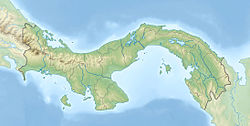| Charco Azul Formation | |
|---|---|
| Stratigraphic range: Pliocene | |
| Type | Formation |
| Unit of | Charco Azul Group |
| Underlies | Armuelles Formation |
| Lithology | |
| Primary | Shale |
| Other | Tuff |
| Location | |
| Coordinates | 8°30′N82°48′W / 8.5°N 82.8°W |
| Approximate paleocoordinates | 8°18′N82°12′W / 8.3°N 82.2°W |
| Region | Chiriquí Province |
| Country | Costa Rica, Panama |
| Type section | |
| Named for | Charco Azul |
Charco Azul Formation is a geologic formation of the Charco Azul Group in western Panama and southeastern Costa Rica. It preserves gastropod fossils dating back to the Pliocene period. [1]
